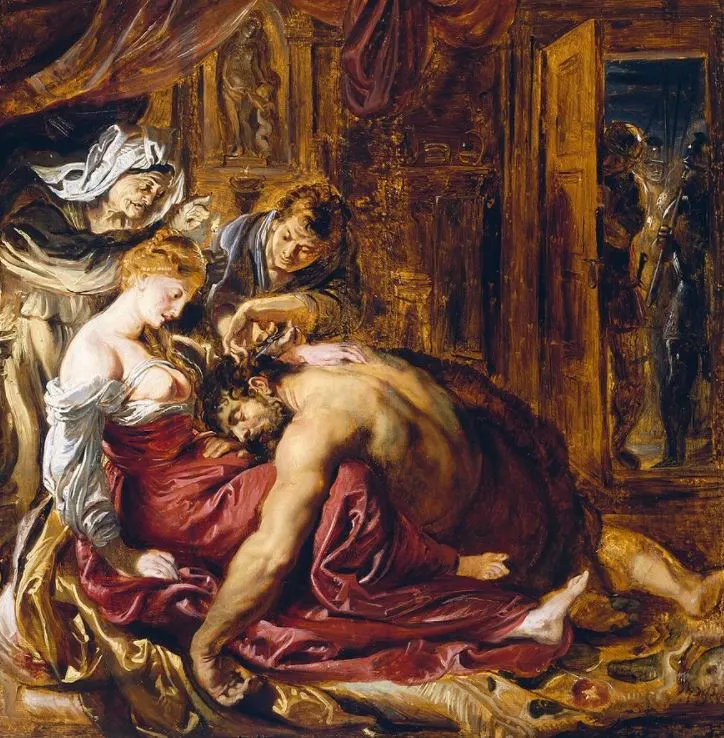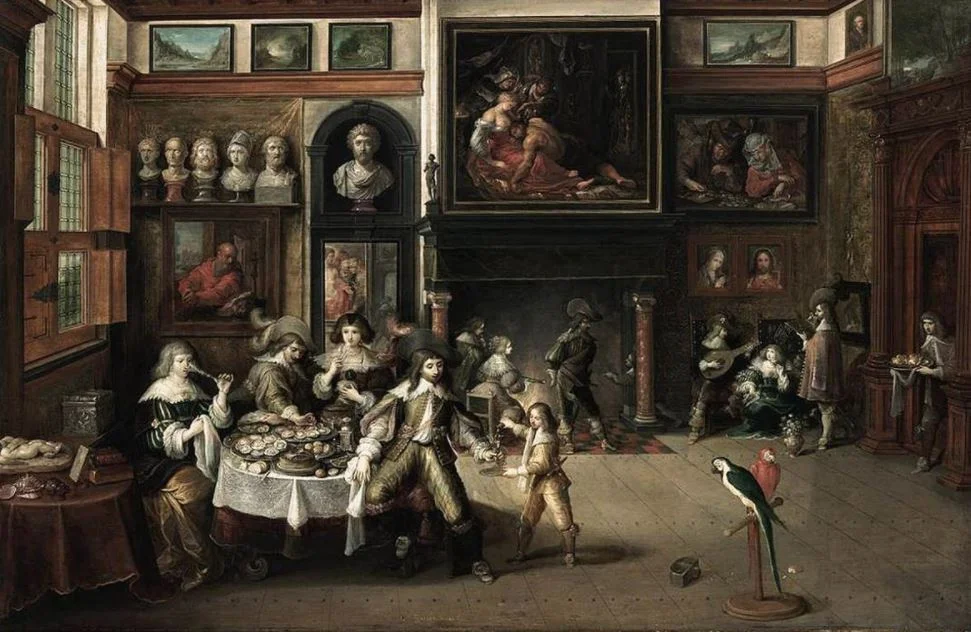When Flemish painter Peter Paul Rubens (1577-1640) came back from his extended trip to Italy in the year 1608, the patrons in his hometown of Antwerp were lining up to order one of his masterpieces.
One of the works from this period of the Baroque artist is called “Samson and Delilah“, and in this article, you’ll discover some of the most interesting facts about this remarkable Baroque painting in the artist’s oeuvre.
1. It depicts a famous scene from the Old Testament
The painting depicts the crucial scene of the story of Samson and Delilah from “Judges 16 ” in the Old Testament. Samson is a Hebrew hero who falls in love with Delilah and in the spur of the moment reveals his biggest secret.
Delilah is bribed by the Philistines to reveal it and mentions that his strength is in his hair. The picture captures the moment that a young boy is cutting Samson’s hair as he is sleeping on Delilah’s lap.
The Philistine soldiers can be seen just outside the door as they are eagerly waiting to capture him the moment that his strength is taken away from him.

2. The main work is one of 3 copies of the painting
The main version of the work is an oil on wood painting that has dimensions of 185 × 205 centimeters (73 × 81 inches) and which was completed between 1609 and 1610.
What’s remarkable is that this isn’t the only version of the work because there’s also an oil sketch on a wood panel and ink on paper drawing. The latter is part of a private collection located in Amsterdam.
The oil sketch is significantly smaller than the main version as it has dimensions of 52.1 × 50.5 centimeters (20.5 × 19.9 inches). This sketch is on display at the Cincinnati Museum of Art in Ohio.

3. It was commissioned by one of Ruben’s close friends
Rubens was much more than a painter because he was also a diplomat from the Duchy of Brabant, a state of the Holy Roman Empire in the Southern Netherlands at the time.

This means that he traveled quite a bit and hung out with some of the most influential people in Europe. This allowed him to get commissions from the most prominent members of society, including royalty.
This particular painting was commissioned by a close friend of his, the Mayor of Antwerp at the time, a man named Nicolaas Rockox (1560-1640).
The painting decorated the man’s house during his lifetime as can be seen in a painting of Frans Fracken the Younger (1518-1642) called “Supper at the House of Burgomaster Rockox” (1630-1635).

4. The history of the painting remains obscure until the year 1929
What happened to the painting after Mayor Rockox died in 1640 remains pretty much unknown. It was publicly sold following his death but the identity of the buyer remains a mystery.
It’s assumed that it was sold again in the year 1700 to Prince Johann Adams Andreas I (1662-1712), a Prince of Liechtenstein. This means that Samson and Delilah potentially became part of the Liechtenstein Collection in Vienna, Austria.
Even though this is probably what happened, the name of the painting in the collection was identified as Jan van den Hoecke (1611-1651), another Flemish painter who was a prominent assistant in Rubens’ workshop.
It took nearly 200 years before the painting emerged again, this time in Paris in 1880 where it was sold again in an auction. Prominent Rubens Scholar Ludwig Burchard (1886-1960) discovered the painting in 1929.

5. It’s on public display in a popular museum in London
One thing is certain, the painting ended up being bought by one of the most famous museums in London for USD 5 million in 1980.
It was sold to the in auction house Christie’s by the National Gallery, a hefty sum but then again, this is one of the masterpieces of one of the most famous Baroque artists in history.
Today, the painting remains on public display in this museum located at Trafalgar Square in the City of Westminster in Central London.

More facts about Samson and Delilah by Rubens
6. The old woman standing right behind Delilah lights up the room with a candle. What’s remarkable about this figure is that she isn’t part of the story mentioned in the Old Testament.
It’s assumed that this old woman has a double meaning in the scene. She is assumed to be a procuress, a woman who procures prostitutes, as well as the old version of Delilah herself.
7. The man cutting Samson’s hair is crossing his hands which is a sign of betrayal. The niche in the background features a statue that depicts the goddess Venus with her son Cupid. The mouth of Cupid is bound, another reference to the betrayal taking place.

8. Shortly after the painting was bought by the National Gallery in London in 1980 it was thoroughly investigated. What’s remarkable is that Rubens didn’t use any blue pigments.
He did use a combination of carmine (kermes) lake (natural red), lead-tin-yellow, vermilion, and ochres. He combined these colors with lead white and charcoal black.
9. Even though the painting was attributed to other painters at some points in its history, multiple investigations have conclusively led to it being attributed to Rubens.
A dendrochronological examination, a scientific method to determine the age of things, has placed it in the correct time period as well.
10. The house in which the painting hung during the first half of the 17th century still exists today. It has been turned into a museum known as the “Rockox House.”
As expected, this museum in Antwerp has several paintings of Old Masters on display, including the “Rockox Triptych” also known as “The Incredulity of Saint Thomas.”
The year 1610 not only marked the completion of Samson and Delilah but also the year that Rubens moved into his own residence in Antwerp, now a museum known as the Rubenshuis.

